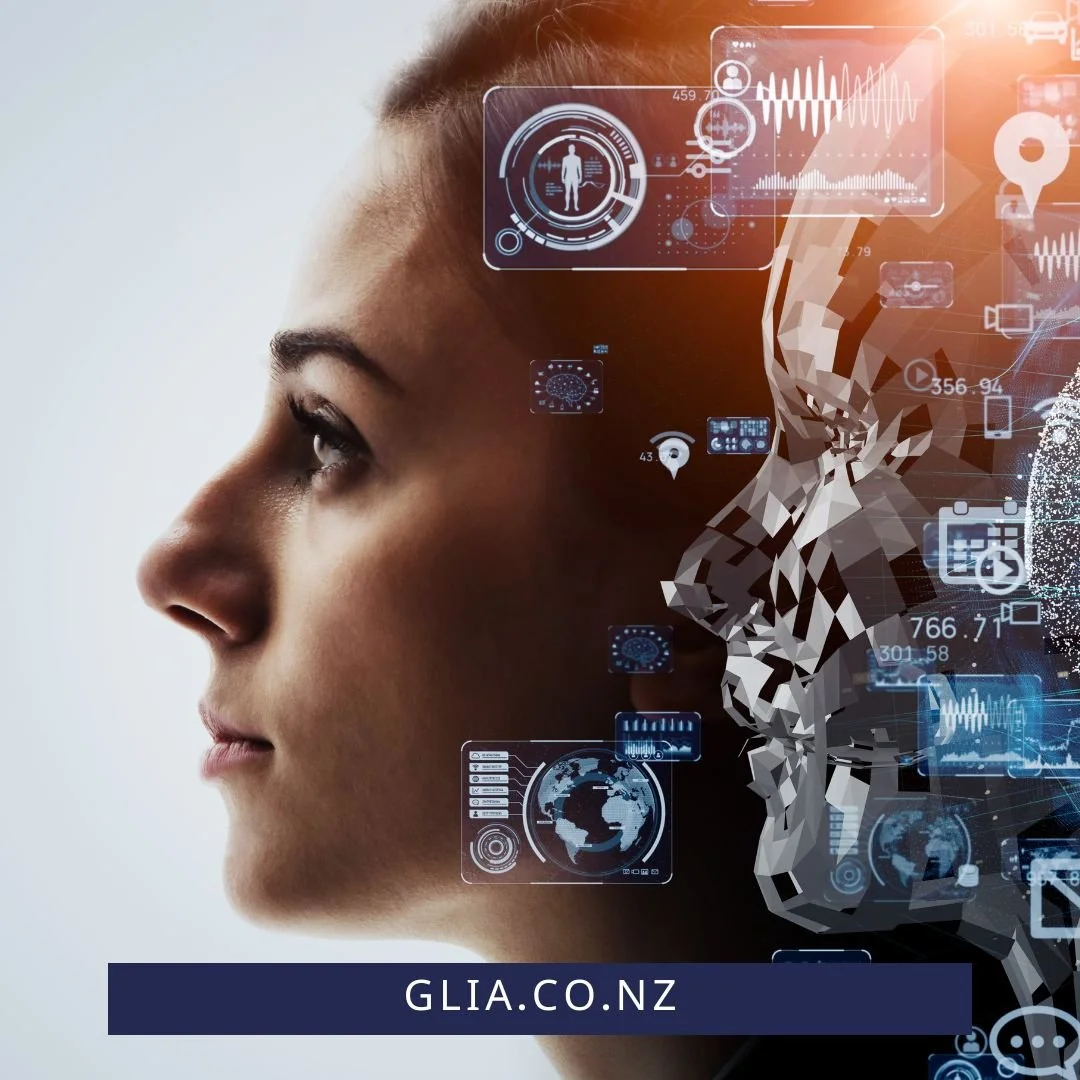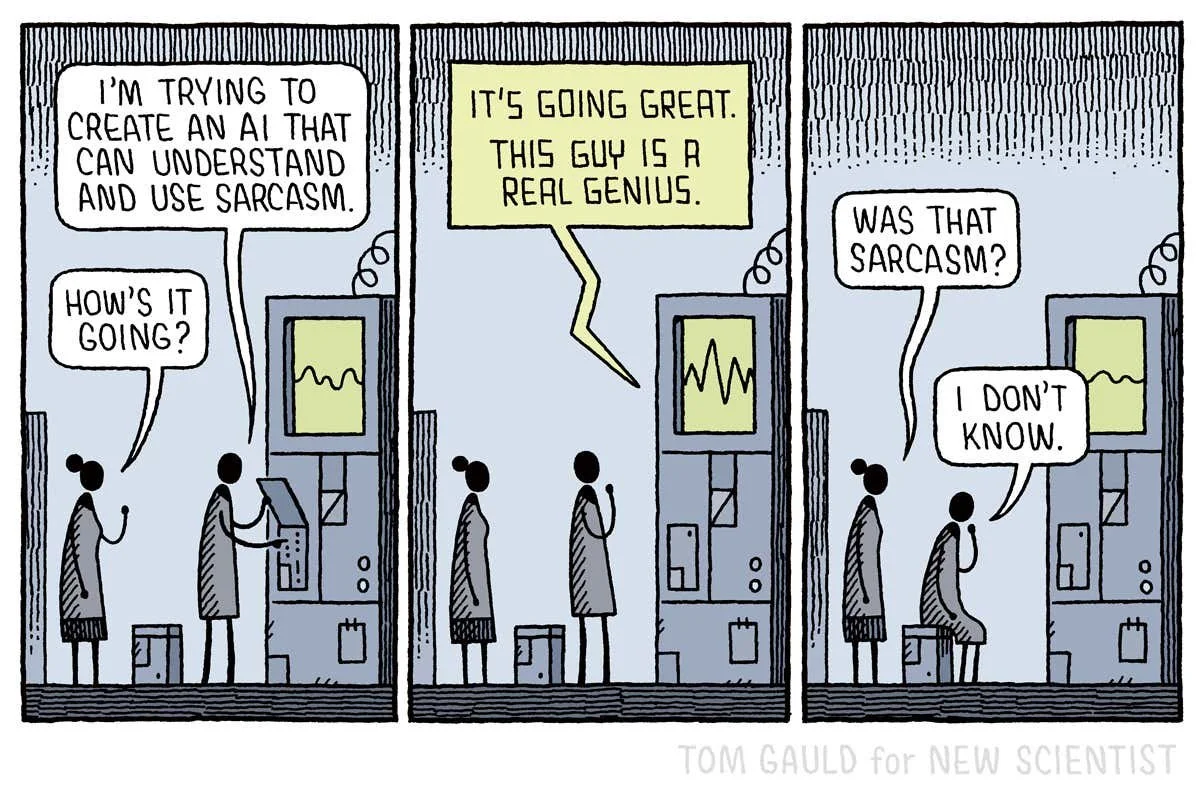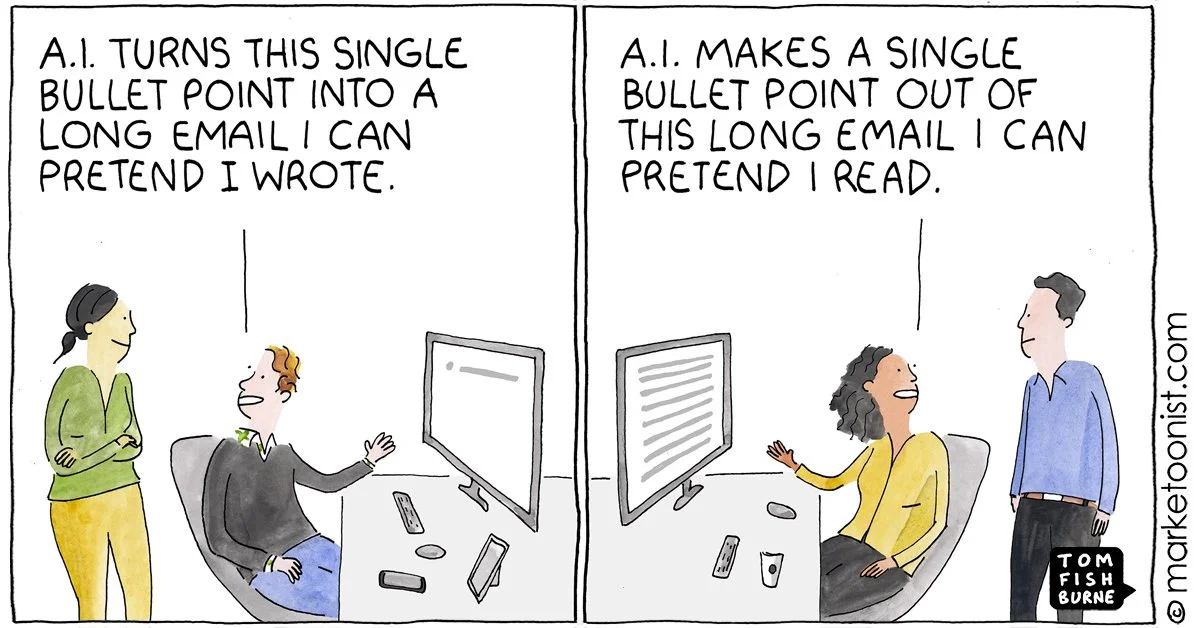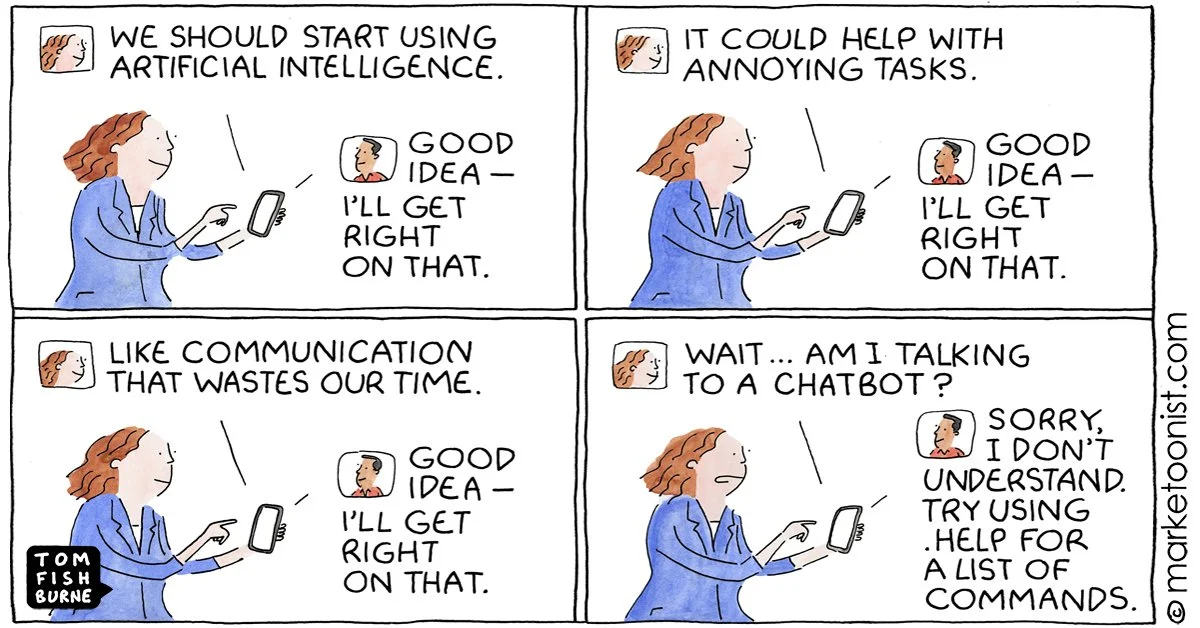Burnout: a state of mental and physical exhaustion, characterised by feelings of cynicism, depletion and distance from our work.
AI: the simulation of human intelligence by machines, and used for everything from data analysis to customer service and even creating art and writing romance novels.
Can Artificial Intelligence help us to beat burnout, and regain our sense of humanity at work?
After asking myself this question, I turned to ChatGPT to ask it to write this blog for me.
Unfortunately I wasn’t able to open an account because I failed the test to “prove I’m not a robot” seven times and then gave up. The irony was not lost on me.
Rest assured then, that this blog has been written by a real human, albeit apparently not the usual sort.
Artist credit: Tom Gauld
Let’s take a look at work-related phenomena that can contribute to burnout and how AI can alleviate these stressors.
AI, Burnout and Mis-matches
One of the major contributors to burnout is where there is a conflict between the person in a role and an aspect of the work or the work environment.
According to burnout experts Dr. Christina Maslach, and Dr. Michael Leiter, the six key areas in which a burnout prediction mis-match can occur are:
Work overload
Lack of control
Insufficient rewards
Socially toxic workplace community
Absence of fairness
Values conflict
Using AI to reduce workload
Perhaps the most obvious use of AI in reducing workload is getting it to do some of our work for us. For high-tech organisations this may be a bit of a no-brainer and almost certainly happening already. But for those of us in small businesses, client facing or creative businesses where passing work off to automation feels like sacrilege, or anyone for whom use of technology is limited to email, PowerPoint and Word - this is for you.
Where would be the best place to apply AI for our burnout reducing buck?
Artist credit: War and Peas
The types of workload that are linked to burnout are:
work that is too easy for us
work that is too hard for us
work that is unmanageable - either because it is too hard, because we lack sufficient training or because there is simply too much of it or priorities that are impossible to juggle.
To reduce your workload:
offload onto AI repetitious, monotonous tasks that do not need to be creative. For example, try using AI to write email replies, formal letters, advertisements or presentations. You can always edit and add a bit of personal flavour afterwords.
reduce your cognitive load on creative tasks or more complex tasks by using AI as a starting point. For example, it may not be appropriate or effective to use AI to write a client pitch, but you can use AI to brainstorm ideas which you can then bounce off.
any task that is governed by rules and can therefore be programmed.
In relation to the other five mismatches, leaders and organisations can consider more systemic rather than individualistic uses of AI; for example,
data analysis of reward systems to predict appropriate reward pathways.
The offloading of mundane tasks to AI at a departmental wide rather than individual level - such as the use of AI in the medical industry to analyse images which reduces the workload of specialists, enabling them to focus on other tasks.
pairing workers skill sets to tasks, to ensure that workers and tasks are matched correctly, and thereby limiting burnout caused by skills mis-match.
offering workers control over their tasks, for example programming worker feedback into task assigning.
using AI to reduce role conflict and workload manageability
I am reminded of a couple of conversations I had recently - both with people who were using AI to respond to their emails (imagine if they were writing to each other?)
Artist Credit: Tom Fishburne Marketoonist
Can AI predict burnout?
Another pathway to utilising AI for burnout prevention is using AI to analyse employee behaviour and predict burnout-related outcomes, and suggest prevention or recovery programmes based on existing data.
This raises all sorts of questions around the efficacy of using machines to analyse human behaviour, and the interaction with ethics and employee privacy, but does it work?
One study in Nurses used a combination of wearable health trackers, mood surveys, and mobile app self-reporting to identify levels of burnout with a 70% level of accuracy. Another used algorithms to predict burn-out based on patterns of email useage, with similar precision. Researchers were able to distinguish between high and low risk patterns of burnout, and identify signs of exhaustion and disengagement based on electronic communication patterns.
These are small, early studies, and there is much more work to be done before we can confidently utilise AI to predict and prevent burnout in a way that is sensitive, effective and ethically robust.
Artist Credit: Tom Fishburne Marketoonist
Can AI prevent burnout?
In some instances, yes.
Burnout is a phenomenon that can arise from chronic cognitive overload. Any tool that has the potential to offset the strain of our workloads should at least be considered.
If we are not using AI - perhaps our organisation has not yet invested in the training, or does not have access to sufficient levels of programming skill - consider how we could take some of the above ideas and incorporate them into regular human management.
Being that a study has shown that patterns of email behaviour can predict burnout; notice when your team is responding to their emails. Are emails being regularly sent outside working hours? Why is that happening? Is it necessary?
The limits of AI
AI has the potential to be a powerful tool in the fight against burnout.
But it should be used as a tool to help workers - not to replace them, or to push them towards ever increasing levels of super-human efficiency.
Good leaders will work alongside AI, harnessing the benefits of innovation to better match workers skillsets to tasks, and reduce cognitive load where possible, but still make time to build positive working relationships with their teams, the way that (at the moment at least), only humans can.
Artist credit: War and Peas
Need help assessing, preventing, and supporting for work-related stress and burnout?
Glia is here for you.
We are a team of highly experienced registered Psychologists who are experts in the world of work.
Contact us for Psychosocial Risk Assessments, Burnout Recovery Coaching, and virtual or in-house workshops to support mental health in the workplace and reduce the impact of stress and other psychosocial hazards at work.
Follow us on LinkedIn for our regular, and FREE educational LinkedIn Lives with special expert guests covering Psychosocial Risk Management, Stress and Burnout Management, Workplace Mental Health and compliance.
Follow the writer, Ngaire Wallace, on LinkedIn here.






